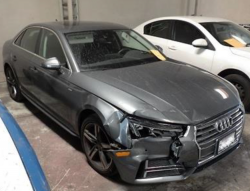
— A California Tesla Model X crash that killed the driver has caused a lawsuit from an Audi driver whose car was hit by the Tesla.
On March 23, 2018, the 2017 Tesla Model X approached the US-101/SR-85 interchange as it traveled in the second lane from the left, a lane for continued travel on southbound US-101.
Plaintiff Jumana Muwafi was driving her 2017 Audi A4 south on US-101 behind the Tesla Model X when the Tesla suddenly steered left and into the gore area dividing the 101 and 85 exit ramp. The Model X slammed into a damaged crash attenuator, a device installed to allegedly decrease the force of a crash.
The Tesla was traveling 71 mph and neither the vehicle or the Tesla driver took any action to avoid the crash. The Tesla collided with the attenuator and ricocheted back into southbound US-101 where it was hit by the Audi.
According to the National Transportation Safety Board (NTSB) which investigated the crash, the "2017 Audi A4 sustained damage concentrated in the area of the right front bumper, headlamp, and hood." (Photo above)
The plaintiff says she has been "compelled to incur obligations for medical services, hospitalization, radiological and imaging studies, medicines, medical supplies, and therapies, and in the future will be compelled to incur additional similar obligations."
The lawsuit says the plaintiff has also been caused to "lose earnings and earning capacity and will in the future continue to sustain said losses" due to Tesla's negligence and carelessness.
According to the lawsuit, Tesla driver Wei Huang "reasonably relied" on Autopilot to be safer than a human-operated vehicle because of Tesla's claims about "technical superiority regarding the vehicle's Autopilot, Traffic-Aware Cruise Control, and Autosteer lane-keeping assistance systems, as well as other safety related components."
Alleged defects in the design and manufacture of the Model X put the driving public in danger and caused the plaintiff's injuries and damages. The automaker allegedly should have known the Autopilot system could cause the vehicle to travel outside its intended lane and strike a fixed object.
The Model X allegedly had no way to monitor the driver's level of engagement and failed to provide proper alerts and warnings to the driver.
According to the plaintiff, Tesla could have warned 2017 Model X owners about the dangers of Autopilot and the lack of an effective automatic emergency braking system that should have slowed down the Model X.
The Tesla Model X crash lawsuit was filed in the Superior Court of the State of California, County of Santa Clara: Jumana Muwafi, vs. Tesla Inc., et al.
The plaintiff is represented by Abramson Smith Waldsmith, LLP.




